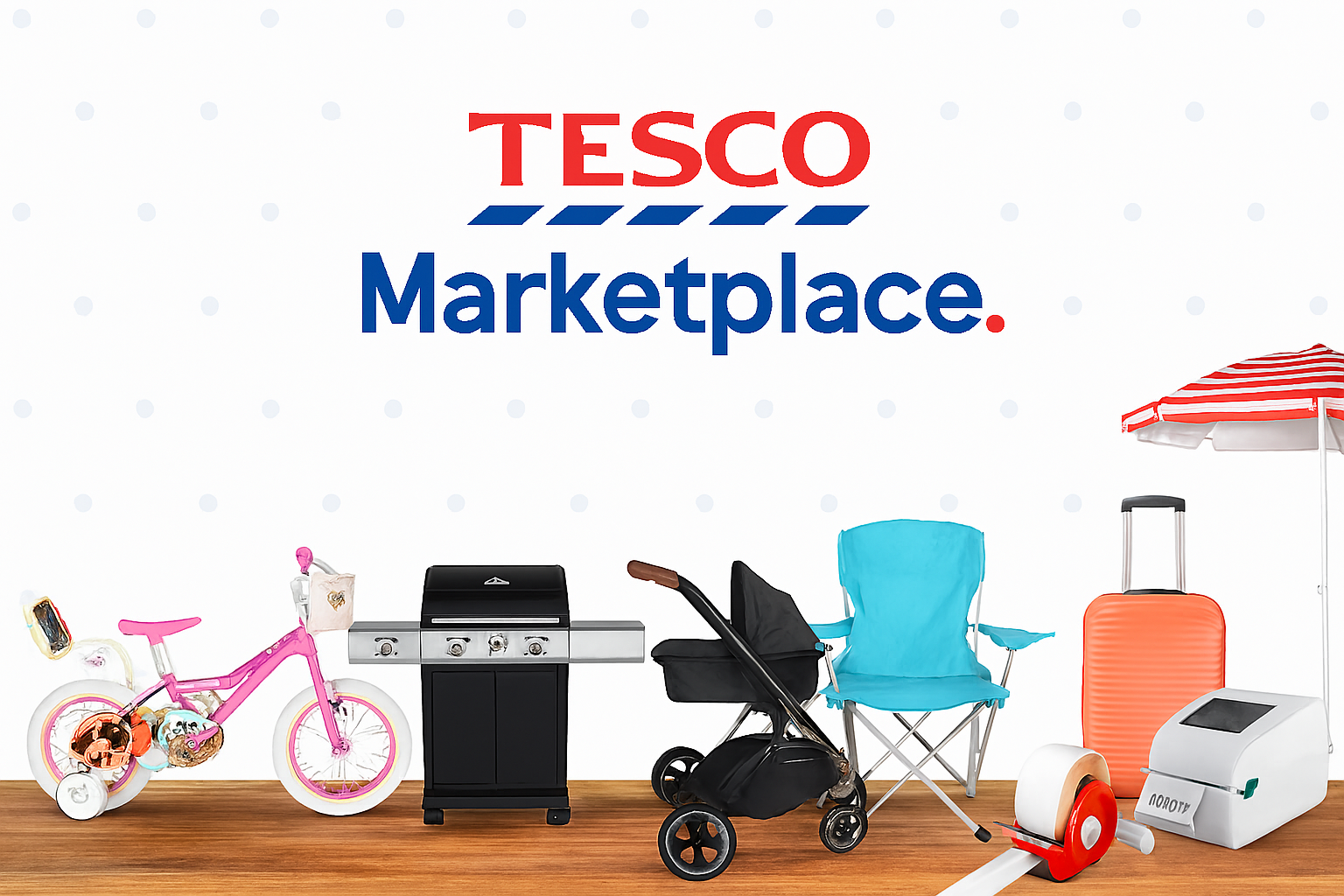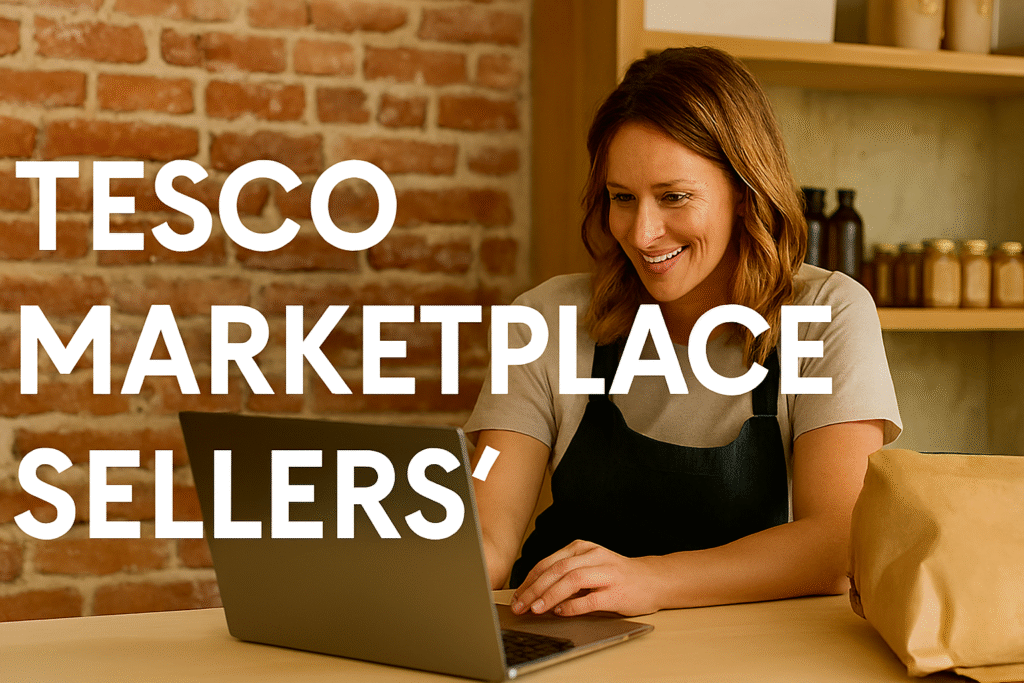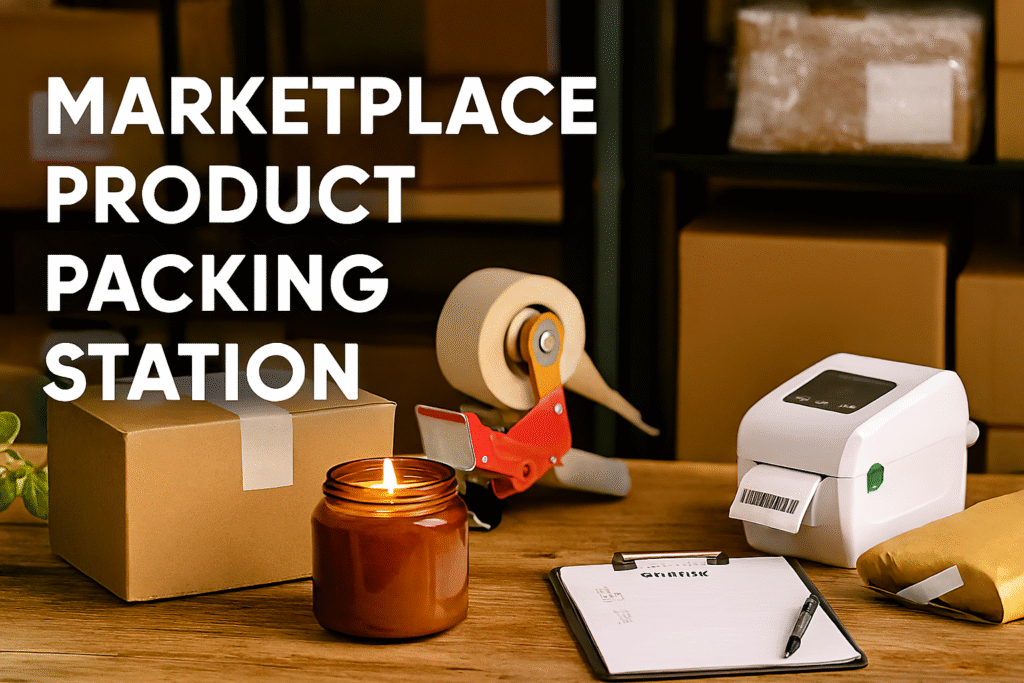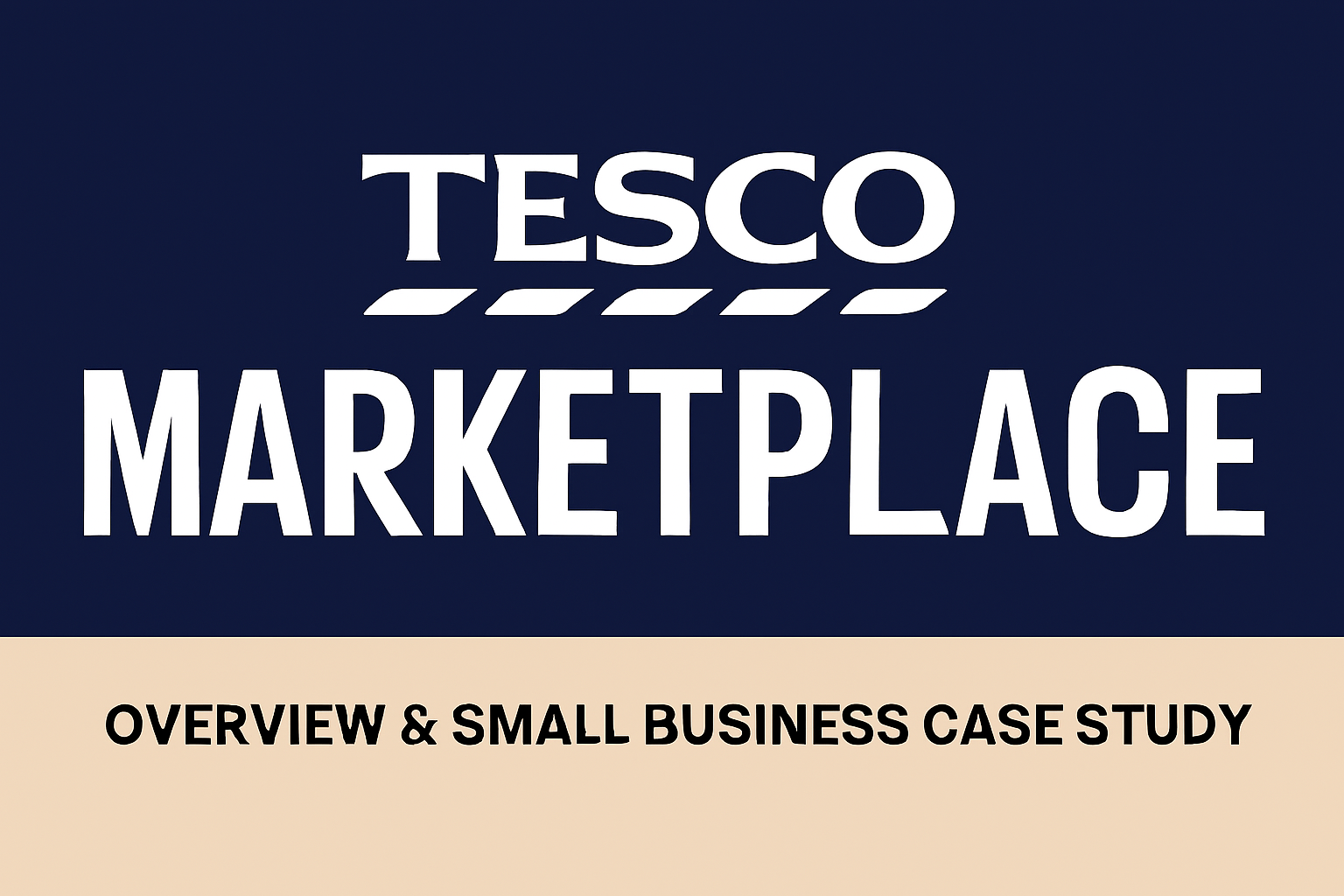Your Complete Guide to Selling on Tesco Marketplace: Opportunities, Challenges & Winning Strategies
Introduction: Why Tesco Marketplace Should Be On Every UK Small Business Owner’s Radar
In the fast-evolving landscape of UK e-commerce, Tesco Marketplace has quickly become one of the most intriguing platforms for ambitious small businesses and entrepreneurs. Launched by Tesco—Britain’s largest supermarket chain—as an “online mall” integrated into its main grocery website, the marketplace offers third-party sellers the opportunity to reach Tesco’s enormous weekly audience and leverage the trusted Tesco brand. Whether you run a small crafts business in the Midlands or manage a health-food startup in London, Tesco Marketplace presents new chances to showcase products, access millions of potential customers, and supercharge your digital growth.
Yet as with any marketplace, Tesco’s platform comes with unique features, fees, pros, and pitfalls. This guide, crafted for SBC Marketing London’s blog readers, will not only define and demystify Tesco Marketplace, but also analyse its business model, onboarding process, integration options, and how to optimise your listing for search. You’ll discover real-life success through a detailed case study—plus expert tips on marketplace SEO, competitor platforms, and strategies for maximising your brand’s visibility. Read on to make sense of whether Tesco Marketplace fits your business, and discover how SBC Marketing London can help you succeed.
What Is Tesco Marketplace? A Comprehensive Overview
Tesco Marketplace is an online platform launched by Tesco PLC in late 2023, designed to allow third-party businesses to sell their products directly to Tesco’s customer base via Tesco.com. The marketplace is seamlessly integrated within Tesco’s main grocery e-commerce site, making it visible to millions of regular shoppers. This move positioned Tesco as a formidable competitor to other online marketplaces such as Amazon, eBay, and Asda’s George.com. The offering builds on Tesco’s established digital infrastructure and reputation, aiming to diversify Tesco’s retail proposition while providing opportunities for partners to tap into a loyal, nationwide audience.
Key aspects to note include Tesco’s focus on non-food categories—household, homeware, DIY, toys, and technology—though the vision includes gradually expanding the range. Products sold on Tesco Marketplace do not qualify for the supermarket’s expedited home delivery; instead, delivery terms are set separately by each third-party seller, though buyers collect Clubcard points when shopping Marketplace items.
Crucially, all third-party listings appear within the main Tesco.com search and browsing experience, supporting a frictionless discovery process: for end customers, there’s no need to switch platforms or create extra accounts. Marketplace sellers thus benefit from both trust by association and huge brand awareness.
Key Features of Tesco Marketplace
Tesco’s marketplace platform incorporates several features designed to attract and support small businesses selling online. Below, these are summarised within a Markdown table for at-a-glance reference.
The table above highlights that Tesco Marketplace is purpose-built to make onboarding and trading straightforward for third-party brands, while leveraging Tesco’s powerful incentives (like Clubcard points) to boost shopper engagement. A particular benefit for sellers is the seamless inclusion in the main Tesco product search, which places independent products in a trusted retail environment and levels the playing field against established, own-brand offerings.
In addition, the seller dashboard is a significant asset, providing user-friendly management tools for monitoring inventory, pricing, sales analytics, and customer queries. This makes Tesco’s platform a highly accessible and potentially lucrative channel for brands with strong operational discipline. However, the delivery and returns framework is decentralised—each seller must manage their logistics, creating both flexibility and extra responsibility.
How Does the Seller Onboarding Process Work?
For aspiring marketplace merchants, the onboarding process is designed to be accessible yet rigorous, ensuring both seller credibility and customer safety. Here’s an overview of the key steps to join Tesco Marketplace:
Sellers start by providing details via Tesco’s online supplier portal, including company credentials, product range, and proof of regulatory compliance. Tesco reviews applications to check eligibility (including anti-counterfeit checks, liability insurance, and business credentials). Accepted brands can then set up a seller account, upload products, and set custom delivery/return policies using the platform’s seller dashboard.

Once accepted, sellers receive access to the Marketplace’s backend system, where they can:
- List products and include images, pricing, and inventory levels.
- Define delivery fees, service areas, and expected dispatch times.
- Manage customer messages and handle order issues independently.
- Track sales, returns, and analytics in real-time for ongoing performance optimisation.
Tesco typically communicates onboarding decisions within two to four weeks, though highly regulated product categories may require extra vetting. Sellers must also agree to Tesco’s seller code of conduct and data privacy commitments. The entire process is digital, and Tesco’s supplier relations team is available to support sellers with technical or compliance questions during this phase. Recent updates in 2025 show a continued emphasis on onboarding efficiency and improving seller support as the platform scales.
Fee Structure and Pricing Model: What Does It Really Cost to Sell on Tesco Marketplace?
For small businesses, knowing the true cost of marketplace sales is key. Tesco Marketplace operates a clear, competitive fee structure designed to keep entry barriers low while aligning incentives for quality and growth.
Core Pricing Model
- Commission Fees: Tesco charges sellers a percentage commission for each item sold, with rates varying by product category. Commission typically ranges from 10% (for categories like homeware and tech accessories) up to 20% for some higher-maintenance categories.
- Listing Fees: As of 2025, there are no fixed monthly listing fees, a significant difference from some platforms (e.g., Amazon’s Professional Seller Plan).
- Transaction Fees: A small per-transaction fee applies, typically under £1 per order, covering payment processing and administration.
- Delivery Costs: Sellers set their own delivery charges and policies, which must be clearly displayed to customers on Tesco.com. Sellers bear logistics costs directly, unlike fulfilment services such as Amazon FBA.
It is important for prospective sellers to read the small print carefully, as commission and transaction rates may be updated or revised depending on performance, volume, or promotional campaigns. Tesco’s approach is designed to reduce risk for SMEs: you only pay when you make a sale. Compared to other major online marketplaces, Tesco is often perceived as offering competitive fees and a favourable cost structure for newer businesses looking to experiment without incurring high upfront costs.

Integration with E-commerce Platforms: Plug and Play for Shopify & Beyond
One of Tesco Marketplace’s key advantages for agile small businesses is its compatibility with modern e-commerce tech stacks. Tesco has invested in integration tools and open APIs that enable seamless listing and inventory synchronisation for leading platforms like Shopify, WooCommerce, and custom-built e-commerce stores.
Specialist channel management apps and middleware, such as ChannelUnity and Synchron.io, allow retailers to export products, sync inventories, and route orders directly from their e-commerce platform to Tesco Marketplace—with automatic stock level updates, order acknowledgements, and pricing updates.
Example Integration Flow (Shopify):
- Install the relevant connector app (e.g., via ChannelUnity or Synchron.io).
- Map product data fields (e.g., SKUs, titles, variants, images) for compatibility.
- Push selected products to Tesco Marketplace with a few clicks.
- Orders placed on Tesco Marketplace are synchronised back into the Shopify store for centralised management.
- Inventory and pricing changes update in real-time to prevent overselling.
This “plug-and-play” approach dramatically reduces manual admin for established e-commerce retailers and is especially valuable for fast-scaling SMEs or those seeking to test multiple online channels concurrently. Importantly, Tesco’s integration partners offer step-by-step guides and support, lowering the digital learning curve for less technical teams.
E-commerce Marketplace Integration
It should be noted that direct API access may require some technical assistance, so working with a specialist consultant (such as SBC Marketing London) can ensure correct setup and ongoing support—helping small brands avoid common integration pitfalls that could otherwise result in lost orders or customer frustration.
Advantages of Selling on Tesco Marketplace
Tesco’s marketplace is designed with both scale and trust in mind, leveraging the supermarket giant’s vast infrastructure and brand equity to create a supportive ecosystem for sellers. For UK small businesses and startups, there are several high-impact advantages:
1. Access to an Enormous, Trusting Customer Base
Tesco is the UK’s largest supermarket, with over 4,000 stores and an online customer base of millions. Marketplace sellers gain exposure to an audience far larger and more demographically diverse than could be reached independently. By associating with the Tesco brand, even previously unknown brands can earn rapid consumer trust—particularly important in the early launch phase of a new product or company.
2. Enhanced Discoverability for Small Brands
Products listed through Tesco Marketplace are surfaced in the main Tesco.com search and category browse pages, meaning shoppers encounter them alongside Tesco’s own offers—not in a hidden “marketplace” tab. This prime digital estate is essential for building brand awareness and winning impulse purchases. Clubcard integration further incentivises shoppers to favour Tesco’s online environment over out-of-ecosystem competitors.
3. Lower Upfront Costs and Reduced Financial Risk
With no monthly listing fees and a pay-as-you-sell commission structure, Tesco minimises financial exposure for new or small brands. The lack of binding contracts means sellers can test products, categories, and marketing tactics iteratively before making significant investments in stock or media. Tesco’s model is especially attractive to businesses wary of Amazon FBA’s fixed costs, or those priced out of eBay’s category and ad fees.
4. Flexible Fulfilment and Product Control
Sellers manage their own shipping policies, pricing, and returns—allowing full control of margins and customer experience. This flexibility, compared to Amazon’s FBA or eBay Fulfilment, is ideal for niche producers or local manufacturers with bespoke delivery models or sensitivity to transportation costs.
5. Brand Storytelling and Differentiation
Tesco allows sellers to display their brand logo, summary, and key attributes on product pages, providing much-needed digital “space” to tell stories, reinforce values, and differentiate from white-label competitors. This is vital for artisans, ethical traders, and B2B startups building up their reputations.
6. Efficient Onboarding and Expert Support
Compared to many global platforms, Tesco’s onboarding process is genuinely tailored for British SMEs. Evidence of ongoing support, dedicated seller operations, and clear communication helps sellers solve compliance or technical issues before they spiral. Third-party app integration and open APIs enable fast setup using existing technology investments.
Why These Advantages Matter
For small businesses in the UK, especially those struggling to establish brand identity and can’t compete on advertising budgets, Tesco Marketplace’s traffic, trust, and upfront transparency are uniquely appealing. The model supports incremental growth without locking brands into punitive contracts or obscure systems. This “safe stepping stone” approach is vital in uncertain economic times and decreasing digital ROI across generic ad platforms. Tesco’s commitment to responsible growth, customer safety, and innovation reinforces its appeal as a trusted retail partner.

Disadvantages and Challenges of Tesco Marketplace for Sellers
While Tesco Marketplace offers many strong advantages, small businesses need to consider its limitations and challenges in order to make informed decisions and avoid costly missteps.
1. Commission Fees Can Add Up Over Time
Tesco’s commission model, while competitive, means that profit margins, especially in low-margin categories, can erode quickly. Sellers accustomed to 100% direct-to-consumer sales may need to increase RRP (Recommended Retail Price) to maintain margin, putting them at risk of pricing themselves out of the Tesco.com market. Brands operating with already-tight margins may face increased pressure compared to running their own online stores.
2. Limited Category Range (For Now)
Tesco Marketplace currently maintains a relatively narrow product focus. Food and drink, core groceries, and high-risk categories are generally excluded for third-party sellers, at least for now. Sellers in beauty, apparel, or perishable categories may find themselves unable to list flagship products—limiting the Marketplace’s relevance to their growth plans.
3. You’re Responsible for Fulfilment, Delivery & Returns
Unlike Amazon’s FBA, Tesco does not offer a “fulfilment by Tesco” service for Marketplace merchandise. Sellers must manage their own delivery and returns, handle customer complaints directly, and ensure service aligns with Tesco’s promises. For under-resourced or new businesses, this can create operational strain during peak sales periods, and invite negative reviews if not meticulously managed.
4. Customer Service Standards Are High
Tesco’s reputation for reliability and service means that customer expectations are correspondingly high. Small failures—late deliveries, slow responses to complaints, inadequate packaging—can jeopardise a seller’s standing or trigger delisting if not resolved swiftly. Sellers with insufficient bandwidth or experience in online retail support should review Tesco’s requirements closely before onboarding.
5. Regulatory and Documentation Burden
Tesco expects sellers to provide comprehensive business details, product certifications, proof of regulatory compliance (especially for electronics, toys, and goods aimed at children), and complete liability insurance. This is non-negotiable. In regulated areas like food, the requirements are especially complex—an obstacle for micro-businesses who lack compliance support or experience.
6. Competitive Visibility Is Not Guaranteed
Although Marketplace items appear in search results, competition on Tesco.com is increasing rapidly. Sellers must differentiate their listings with strong images, compelling descriptions, and competitive pricing—or risk poor visibility and slow sales. Free “homepage” placements or native advertising opportunities are not guaranteed for third-party sellers.
7. Negative Seller Experience Reports
While positive experiences are common, there are warning signals reported by some sellers regarding delayed payments, difficult dispute resolution, and unclear communication—especially for first-time merchants navigating the returns or refund process. As forums on Moneysavingexpert and UKBusinessForums have documented, some small businesses have struggled with lack of customer support, order cancellations, or platform bugs during peak times.
Small businesses considering Tesco Marketplace must weigh these factors carefully. Support from experienced e-commerce consultants (like the SBC Marketing London team) can significantly improve success odds, by helping with category selection, compliance, and optimisation tactics—while also troubleshooting early platform pain points.
Tesco Marketplace Case Study: How “HomeGlow Candles” Built a Profitable Side Hustle
Real-world examples are worth their weight in gold. To demonstrate Tesco Marketplace’s potential for UK SMEs, this case study dives into the journey of “HomeGlow Candles”—an independent home fragrance brand founded by Manchester-based entrepreneur Amelia Grant.
Brand Snapshot:
Founded in 2022, HomeGlow Candles produces eco-friendly, hand-poured soy candles, with a strong focus on local sourcing and sustainable packaging. The brand began via Instagram and a small Shopify store, gaining some traction with independent boutiques but struggling to find mass retail exposure.
The Move to Tesco Marketplace
In early 2024, following research into new online channels, Amelia applied to Tesco Marketplace, submitting product details, safety test documentation, and new product imagery. Approval came within three weeks. Guided by Tesco’s onboarding materials, Amelia integrated her inventory using a ChannelUnity connector, mapped product data fields, and set UK-wide delivery at a flat £2.95 per order.
Marketplace Experience & Growth
- Product Discovery: By May 2024, HomeGlow’s candles began appearing in Tesco.com searches for “eco candle,” “ethical homeware,” and impulse-gift categories.
- Sales Channel Impact: Initial weekly sales averaged 15–20 orders, with clear spikes on paydays and during Tesco’s Clubcard promotions. By Q4 2024, HomeGlow had doubled its direct-to-shopify monthly sales purely via Tesco Marketplace exposure.
- Brand Recognition: Clubcard points proved a strong incentive—customers shared positive reviews highlighting both product quality and reward accumulation.
- Order Management: All orders synced back to the Shopify store, allowing Amelia to manage dispatches efficiently. Returns were infrequent (less than 2%), and feedback highlighted careful packaging and fast delivery.

Photo: HomeGlow Candles Product Display
Results & Takeaway
By steadily optimising her listings (keyword-rich product titles, professional imagery, and clear brand story), Amelia scaled her Tesco Marketplace turnover to £2,500/month within six months. This channel became roughly 45% of all online sales within 12 months—with customer reviews reinforcing the “trusted Tesco” cross-brand effect. Amelia credits Tesco’s low entry costs and huge online reach for her ability to shift from a side project to a sustainable, profitable business. She now plans to expand into other home fragrance SKUs as Tesco grows its non-food category support.
This case illustrates the value of marketplace visibility, a well-executed onboarding process, and cross-channel e-commerce management for achieving profitable growth as a small UK brand.
Evaluating Tesco Marketplace Versus Key UK Competitors
Before diving in headfirst, UK small business owners should compare Tesco Marketplace with alternative e-commerce marketplaces—especially Amazon, eBay, and emerging competitors like Asda’s “George at Home” and the Argos Marketplace. Below is a structured comparison:
The strategic advantages of Tesco focus on brand trust, integration in food/grocery search journeys, and strong support for new sellers. Compared to Amazon, Tesco imposes fewer fixed costs and less complex advertising requirements, though its limited non-food product scope and absence of fulfilment services are notable constraints for some sellers. eBay and Asda also offer flexibility but may lack Tesco’s regular, high-frequency repeat traffic in household goods searches.
Regulatory and Legal Compliance: What Every Seller Must Know
Selling on Tesco Marketplace, like any major e-commerce platform, requires compliance with UK consumer protection legislation, product safety directives, and specific Tesco policies designed to keep shoppers safe.
Key Compliance Areas
- Business Registration: All sellers must provide up-to-date company registration information and valid UK VAT credentials (if applicable).
- Product Safety: Goods aimed at children, electricals, or items with regulatory controls (e.g., toys, electronics) must meet UK safety standards, with supporting documentation on file.
- Consumer Rights and Returns: Sellers must comply with distance selling and refund laws, including a clear returns policy, prompt refunds, and transparent contact details.
- GDPR/Data Protection: Any customer data managed via the seller platform must be stored securely according to GDPR requirements.
- Marketplace Policies: Tesco requires sellers to uphold policies regarding product authenticity, ethical sourcing, anti-bribery, modern slavery statements, and anti-counterfeit standards.
New UK laws now place additional duties on online marketplaces to police product quality and seller identity, so sellers should expect more rigorous checks and potential audits in 2025 and beyond.
Given the complexity—especially for regulated goods or food/drink—a professional audit of product documentation and compliance practices is strongly recommended before onboarding. Ignorance or shortcuts can result in removal, fines, or reputational damage.
SEO Optimisation for Tesco Marketplace Sellers: Getting Found and Chosen
Success on any marketplace hinges on discoverability. Tesco sellers must invest time in robust SEO strategies—optimising product titles, descriptions, category placements, and images for maximum exposure in Tesco’s on-site search and Google results.

Marketplace SEO Best Practices:
- Keyword Research: Identify relevant, buyer-intent keywords for Tesco.com and Google. Use specific terms such as “eco cleaning spray UK,” not just “cleaning spray.” Tools like SEMrush, Ahrefs, and Google Keyword Planner inform your selection.
- Product Titles: Place primary keywords at the front, limit to ~65 characters, and differentiate SKUs by main features or USPs.
- Descriptions: Write clear, benefits-driven copy with secondary keywords, including size, colour, unique feature, and compelling reasons to buy.
- Image Optimisation: Ensure images are clear, high-resolution, and capture product from multiple angles. Use descriptive file names and alt text tags for both Tesco.com and your own e-commerce site.
- Category & Feature Selection: Tag SKUs with Tesco’s recommended attributes—this matches listings to searches, filters, and special offers.
- Reviews and Social Proof: Encourage early customer reviews—positive ratings boost click-through and conversion rates both on Tesco.com and in Google snippets.
- Ongoing Monitoring: Monitor which keywords are driving impressions and conversions via the seller dashboard; refine listings accordingly.
These practical steps—especially image and content optimisation—add up quickly to make your listings not just visible, but genuinely irresistible. The effort required is substantial, but so is the opportunity. For new sellers or those migrating from Amazon/eBay, investing in professional product photography and SEO-optimised content is usually a high-ROI move.
Visual Content Integration: How to Use Realistic Photos in Your Blog and Listings
Visual presentation is essential for both marketplace listings and blog content. Tesco.com and successful blogs make extensive use of compelling images—product shots, aspirational lifestyle scenes, infographics, and behind-the-scenes visuals. These assets build trust, enhance SEO, and reinforce your brand’s story.

Small Business – marketplace product packing station
These visual techniques not only increase conversion rates but also enhance user engagement with your narrative—crucial for blog SEO and for winning “the click” on crowded category pages.
Effective Calls-to-Action (CTA): Moving from Information to Action
A well-crafted call-to-action is the linchpin of every successful blog post or marketplace listing. For small businesses, effective CTAs can make the difference between a warm lead and another lost visitor.
Key Elements of an Effective CTA:
- Clarity and Value: Tell the reader exactly what to do and what benefit they’ll gain—“Book a free Tesco Marketplace readiness review with SBC Marketing London” is better than “Contact us.”
- Urgency or Scarcity: Phrases such as “Start before the holiday rush begins,” or “Limited free strategy sessions available” add motivation.
- Social Proof: Remind the reader of other small businesses that have succeeded by acting now.
- Easy Contact Mechanisms: Use clickable buttons, WhatsApp links, or short email forms to remove friction.
- Position Relevance: Place CTAs both at the end and mid-way in long-form content, ensuring they’re visible above-the-fold on mobile and desktop.

Ready to grow your business with Tesco Marketplace? Book your FREE strategy session with SBC Marketing London’s e-commerce experts!
Our team has helped dozens of UK small businesses crack the marketplace code, from brand positioning and SEO to compliance and integration. Don’t let your product get lost in the crowd.
Click here to schedule your call or email hello@sbc-marketing.co.uk now.
The impact of strong CTAs in converting information-seekers into active leads cannot be overstated. Make this a core part of your Marketplace content strategy—on both your own blog and in your Tesco product listings—and you’ll see measurable uplifts in engagement and sales.
Insights on the UK Small Business Audience: What Do Entrepreneurs Want from Marketplaces Right Now?
The UK’s small business landscape is remarkably dynamic—characterised by rapid digitalisation, cost sensitivity, and a strong appetite for new channels. According to research in 2025, most small business owners seek the following in new marketplace partnerships:
- Trust: Association with a reputable high-street brand (like Tesco) matters more than with generic platforms.
- Low Upfront Costs: Entry fees, inventory risk, and technical burdens are veto factors.
- Multi-Channel Simplicity: The ability to plug in existing e-commerce tools and manage via one dashboard is a priority.
- Responsive Support: Sellers want real, human support and fast answers when onboarding or facing technical issues.
- Growth Outcomes: Most are seeking tangible sales returns, not just “brand awareness.”
Final Recommendation: Is Tesco Marketplace Right for Your Small Business?
Tesco Marketplace appears to tick many of these boxes, especially for digitally literate businesses in the homeware, electronics, and gift sectors. The brand’s investment in onboarding efficiency, seller support, and active category management is paying dividends—though scale and category expansion remain areas to watch.
Having explored every angle—from platform features and seller experience to advantages, pitfalls, and real-world case studies—Tesco Marketplace emerges as a high-potential, relatively low-risk option for UK-based SMEs in select product categories. Its scale, brand equity, and transparent fee structure make it especially attractive for businesses wanting to test new digital sales channels without heavy upfront investment. Integration efficiency, strong seller support, and built-in trust add to the platform’s appeal.
Conversely, if your brand relies on speed-of-delivery (e.g., perishable food), global shipping, or operates in excluded categories (like alcohol or cosmetics), or if operational resources for returns and customer service are limited, the platform may prove temporarily restrictive. However, for most modern SMEs in retail-ready verticals, Tesco Marketplace is well worth a serious trial—ideally with expert setup to avoid early missteps.
Get Started Today: Contact SBC Marketing London and Unlock Tesco Marketplace Potential
The Tesco Marketplace opportunity isn’t just about listing your products—it’s about building a lasting brand presence in the UK’s fastest-growing digital channel. Our team at SBC Marketing London has helped dozens of small businesses transition from start-up to scale-up through smart marketplace management, powerful SEO, and ongoing compliance support.
Ready to supercharge your e-commerce growth? Book your FREE Tesco Marketplace readiness audit or strategy workshop with us today.


